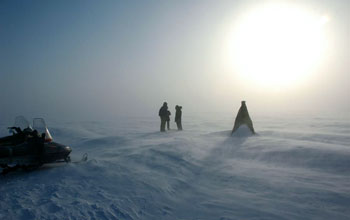Multimedia Gallery
Measuring Snow/Ice Temperatures in the Arctic (Image 2)
Julienne Stroeve of the National Snow and Ice Data Center at the University of Colorado, Boulder, and her research team stand near a marker (pyramid-shaped structure) used by aircraft to stay on course for the researchers' transect measurements. Stroeve's team measured temperatures and other variables at the snow/ice interface in Elson Lagoon in Barrow, Alaska.
Field data collected by Stroeve's team was used to help validate models that predict the potential response of arctic ecosystems to environmental changes, and to validate satellite measurements and help identify variables that can be reliably retrieved from satellites. Because detailed field sampling of ice and snow conditions can only be conducted over limited distances, Stroeve's team also uses aircraft observations to characterize snow and ice conditions in arctic environments. (Date of Image: 2006) [Image 2 of 3 related images. See Image 3.]
Credit: Don Perovich, CRREL, Hanover, N.H.
See other images like this on your iPhone or iPad download NSF Science Zone on the Apple App Store.
Images and other media in the National Science Foundation Multimedia Gallery are available for use in print and electronic material by NSF employees, members of the media, university staff, teachers and the general public. All media in the gallery are intended for personal, educational and nonprofit/non-commercial use only.
Images credited to the National Science Foundation, a federal agency, are in the public domain. The images were created by employees of the United States Government as part of their official duties or prepared by contractors as "works for hire" for NSF. You may freely use NSF-credited images and, at your discretion, credit NSF with a "Courtesy: National Science Foundation" notation.
Additional information about general usage can be found in Conditions.
Also Available:
Download the high-resolution JPG version of the image. (167 KB)
Use your mouse to right-click (Mac users may need to Ctrl-click) the link above and choose the option that will save the file or target to your computer.



